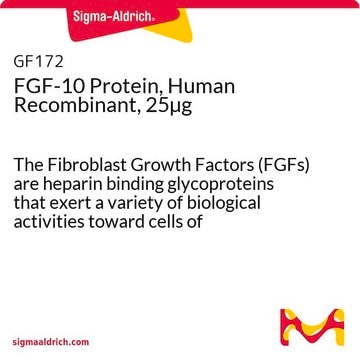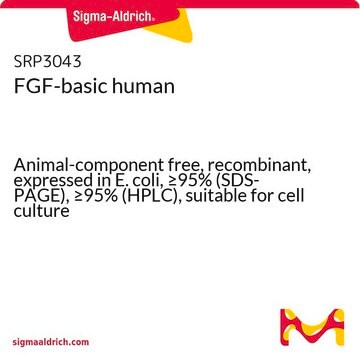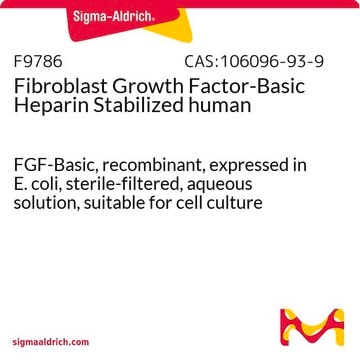GF321
FGF-acidic, Human Recombinant
Animal Free
Synonym(s):
FGF-1, alpha FGF, FGFa
Sign Into View Organizational & Contract Pricing
All Photos(1)
About This Item
UNSPSC Code:
12352202
eCl@ss:
32160405
NACRES:
NA.77
Recommended Products
General description
FGF-acidic is one of 23 known members of the FGF family. Proteins of this family play a central role during prenatal development and postnatal growth and regeneration of a variety of tissues, by promoting cellular proliferation and differentiation. FGFacidic is a non-glycosylated heparin binding growth factor that is expressed in the brain, kidney, retina, smooth muscle cells, bone matrix, osteoblasts, astrocytes and endothelial cells. FGF-acidic has the ability to signal through all the FGF receptors. Recombinant human FGFacidic is a 16.0 kDa protein consisting of 141 amino acid residues.
Product Source: Protein is expressed in E.coli.
The protein is manufactured without the use of any animal products/reagents and is considered Animal-Free and can be used in protocols where possible transmisson of animal viruses and contamination must be avoided.
The protein is manufactured without the use of any animal products/reagents and is considered Animal-Free and can be used in protocols where possible transmisson of animal viruses and contamination must be avoided.
Application
Research Category
Stem Cell Research
Stem Cell Research
Research Sub Category
Growth Factors & Receptors
Growth Factors & Receptors
Quality
Bioactivity assay:
Assay #1: The ED50 as determined by the dose-dependent stimulation of thymidine uptake by BaF3 cells expressing FGF receptors is ≤ 10 ng/ml corresponding to a specific activity of ≥ 1 x 10^5 units/mg.
Assay #2: The ED50 was determined by a cell proliferation
assay using balb/c 3T3 cells is ≤ 0.5 ng/ml in the presence
of 10 μg/ml heparin, corresponding to a specific activity of
≥ 2 x 10^6 units/mg.
Assay #1: The ED50 as determined by the dose-dependent stimulation of thymidine uptake by BaF3 cells expressing FGF receptors is ≤ 10 ng/ml corresponding to a specific activity of ≥ 1 x 10^5 units/mg.
Assay #2: The ED50 was determined by a cell proliferation
assay using balb/c 3T3 cells is ≤ 0.5 ng/ml in the presence
of 10 μg/ml heparin, corresponding to a specific activity of
≥ 2 x 10^6 units/mg.
Physical form
Product is presented in 5 mM Sodium Phosphate, pH 8.0 + 100mM NaCl. and is filtered through a 0.2 micron filter before lyophilization.
Storage and Stability
Store at -20°C for up to 4 months from date of receipt Centrifuge the vial prior to opening.
Reconstitute in 5 mM Sodium Phosphate, pH 8.0 to a concentration of <0.5 mg/ml. Do not vortex. For extended storage, it is recommended to further dilute in a buffer containing a carrier protein and store in working aliquots at -20°C.
Reconstitute in 5 mM Sodium Phosphate, pH 8.0 to a concentration of <0.5 mg/ml. Do not vortex. For extended storage, it is recommended to further dilute in a buffer containing a carrier protein and store in working aliquots at -20°C.
Disclaimer
Unless otherwise stated in our catalog or other company documentation accompanying the product(s), our products are intended for research use only and are not to be used for any other purpose, which includes but is not limited to, unauthorized commercial uses, in vitro diagnostic uses, ex vivo or in vivo therapeutic uses or any type of consumption or application to humans or animals.
Storage Class Code
13 - Non Combustible Solids
WGK
WGK 3
Flash Point(F)
Not applicable
Flash Point(C)
Not applicable
Certificates of Analysis (COA)
Search for Certificates of Analysis (COA) by entering the products Lot/Batch Number. Lot and Batch Numbers can be found on a product’s label following the words ‘Lot’ or ‘Batch’.
Already Own This Product?
Find documentation for the products that you have recently purchased in the Document Library.
Our team of scientists has experience in all areas of research including Life Science, Material Science, Chemical Synthesis, Chromatography, Analytical and many others.
Contact Technical Service





